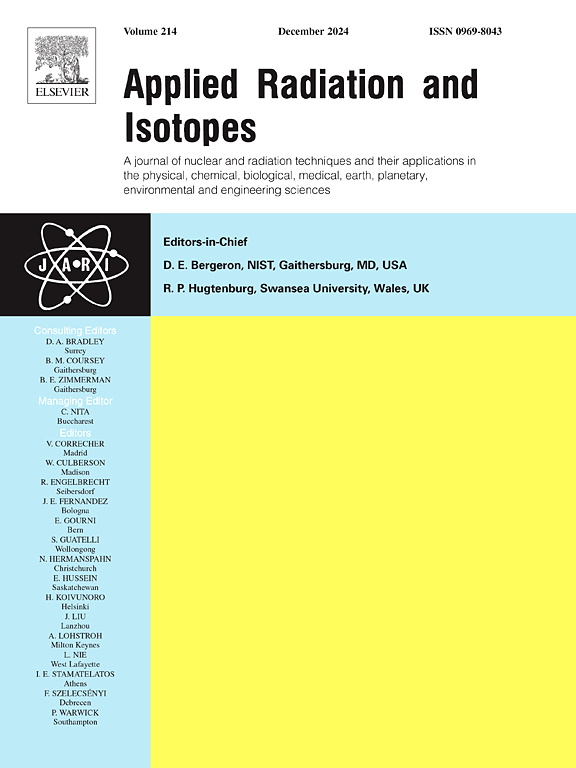利用CdTe-DSD在JRR-3开发BNCT实时硼成像方法
IF 1.6
3区 工程技术
Q3 CHEMISTRY, INORGANIC & NUCLEAR
引用次数: 0
摘要
硼中子俘获疗法(BNCT)是一种基于中子的癌症治疗方法,需要实时10B剂量监测来优化效果。我们报道了使用碲化镉双面条形探测器(CdTe-DSD),其特点是在511 keV下全宽半最大高能分辨率(FWHM)为7.3 keV,空间分辨率为250μm,用于精确的硼成像。在日本3号研究堆(jsr -3)上,采用带针孔准直器的CdTe-DSD,对含10B浓度为0.3 mg的固体样品在中子辐照下的10B分布进行了研究。虽然测量10B信号受到113Cd γ射线背景的显著影响,但我们成功获得了直径为11.5 mm的圆形投影图像,显示了10B的精确位置,计数率为0.115 cps,信噪比约为25.7%。结果表明,CdTe-DSD能够以高保真度提供样品内10B分布的详细信息,从而增强BNCT。本文章由计算机程序翻译,如有差异,请以英文原文为准。
Development of a real-time boron imaging method for BNCT using CdTe-DSD at the JRR-3
Boron neutron capture therapy (BNCT) is a neutron-based cancer treatment requiring a real-time 10B dose monitor to optimize effectiveness. We report using of the cadmium telluride double-sided strip detector (CdTe-DSD), distinguished by its high-energy resolution in full width at half maximum (FWHM) of 7.3 keV at 511 keV and a spatial resolution of for accurate boron imaging. Employing the CdTe-DSD with a pinhole collimator, our experiment at Japan Research Reactor No. 3 (JRR-3) evaluated the 10B distribution in a solid sample containing a 10B concentration of 0.3 mg during neutron exposure. Although measuring the 10B signal is significantly affected by the background from the -rays of 113Cd, we successfully obtained a circular projection image with a diameter of 11.5 mm, revealing the precise location of 10B, with a counting rate of 0.115 cps and SNR of approximately 25.7%. The results reveal the CdTe-DSD’s capability to enhance BNCT by providing detailed insights into the 10B distribution within the sample with high fidelity.
求助全文
通过发布文献求助,成功后即可免费获取论文全文。
去求助
来源期刊

Applied Radiation and Isotopes
工程技术-核科学技术
CiteScore
3.00
自引率
12.50%
发文量
406
审稿时长
13.5 months
期刊介绍:
Applied Radiation and Isotopes provides a high quality medium for the publication of substantial, original and scientific and technological papers on the development and peaceful application of nuclear, radiation and radionuclide techniques in chemistry, physics, biochemistry, biology, medicine, security, engineering and in the earth, planetary and environmental sciences, all including dosimetry. Nuclear techniques are defined in the broadest sense and both experimental and theoretical papers are welcome. They include the development and use of α- and β-particles, X-rays and γ-rays, neutrons and other nuclear particles and radiations from all sources, including radionuclides, synchrotron sources, cyclotrons and reactors and from the natural environment.
The journal aims to publish papers with significance to an international audience, containing substantial novelty and scientific impact. The Editors reserve the rights to reject, with or without external review, papers that do not meet these criteria.
Papers dealing with radiation processing, i.e., where radiation is used to bring about a biological, chemical or physical change in a material, should be directed to our sister journal Radiation Physics and Chemistry.
 求助内容:
求助内容: 应助结果提醒方式:
应助结果提醒方式:


